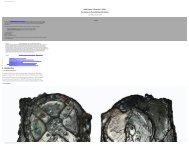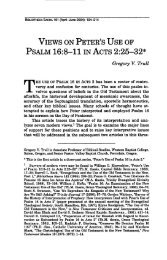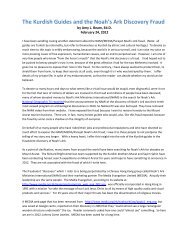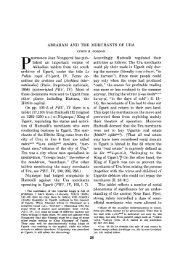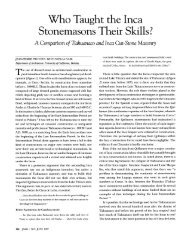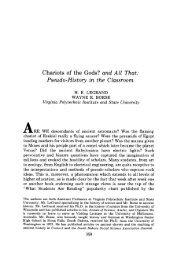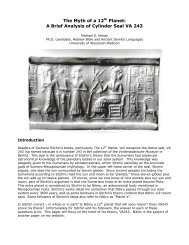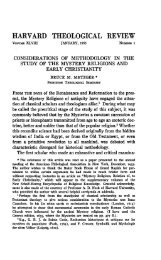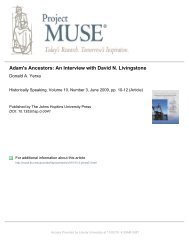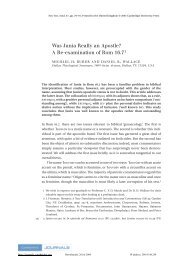Paul's Argument from Nature for the Veil in - Michael S. Heiser
Paul's Argument from Nature for the Veil in - Michael S. Heiser
Paul's Argument from Nature for the Veil in - Michael S. Heiser
Create successful ePaper yourself
Turn your PDF publications into a flip-book with our unique Google optimized e-Paper software.
76<br />
Similarly, Victor Paul Furnish comments:<br />
Journal of Biblical Literature<br />
There is no doubt that Paul also means to provide a <strong>the</strong>ological basis <strong>for</strong> his<br />
<strong>in</strong>structions about <strong>the</strong> hairstyle of women who pray or prophesy, but <strong>in</strong> this<br />
case his argument is obscure, at least to modern <strong>in</strong>terpreters, and it may well<br />
have seemed unsatisfactory even to <strong>the</strong> apostle himself. At any rate, <strong>in</strong> <strong>the</strong><br />
end he abandons argument altoge<strong>the</strong>r by suggest<strong>in</strong>g that if his directives are<br />
not followed <strong>the</strong> Cor<strong>in</strong>thians will be depart<strong>in</strong>g <strong>from</strong> <strong>the</strong> convention that<br />
obta<strong>in</strong>s <strong>in</strong> o<strong>the</strong>r congregations (v. 16). 3<br />
Describ<strong>in</strong>g Paul’s argument as “bewilder<strong>in</strong>gly difficult,” Marion L. Soards<br />
states, “One hopes that <strong>the</strong> Cor<strong>in</strong>thians had an easier time follow<strong>in</strong>g Paul’s logic<br />
than do modern readers.” 4 One may hope, but <strong>the</strong> scholarly assessment is that<br />
nei<strong>the</strong>r <strong>the</strong> Cor<strong>in</strong>thians nor possibly even Paul himself completely comprehended<br />
this argument <strong>for</strong> <strong>the</strong> veil<strong>in</strong>g of women.<br />
While many features of this argument <strong>in</strong> 1 Cor 11:2–16 require explanation,<br />
<strong>the</strong> argument <strong>from</strong> nature <strong>in</strong> vv. 13–15 is particularly problematic. 5 The<br />
rationale <strong>for</strong> <strong>the</strong> natural shame of a man with long hair is obscure (vv. 14–15a).<br />
Especially problematic is <strong>the</strong> statement that a woman’s long hair is given to her<br />
<strong>in</strong>stead of a cover<strong>in</strong>g (ajnti; peribolaivou) <strong>in</strong> v. 15b. As traditionally understood,<br />
this statement nullifies <strong>the</strong> previous argument that a woman should wear a cover<strong>in</strong>g<br />
s<strong>in</strong>ce her long hair apparently serves that purpose. A satisfactory explanation<br />
of this argument <strong>from</strong> nature should resolve <strong>the</strong> apparent contradiction<br />
and enable this argument to support Paul’s contention that women should wear<br />
<strong>the</strong> veil <strong>in</strong> public worship.<br />
The term peribovlaion <strong>in</strong> v. 15b provides <strong>the</strong> key <strong>for</strong> expla<strong>in</strong><strong>in</strong>g this argument<br />
<strong>from</strong> nature. This portion of <strong>the</strong> verse is usually translated, “For her hair<br />
is given to her <strong>in</strong>stead of a cover<strong>in</strong>g (peribolaivou).” In an <strong>in</strong>fluential article,<br />
Othoniel Motta argues that peribovlaion here means some type of head cover<strong>in</strong>g.<br />
Paul Ell<strong>in</strong>gworth and Howard Hatton expla<strong>in</strong>, “The word translated cover<strong>in</strong>g<br />
is a general word <strong>for</strong> a garment, possibly one used as an outer cover<strong>in</strong>g.<br />
Although it does not specify any particular piece of cloth<strong>in</strong>g, <strong>the</strong>re seems to be<br />
an obvious relation between this verse and <strong>the</strong> discussion <strong>in</strong> verses 4 and 5<br />
about a cover<strong>in</strong>g <strong>for</strong> <strong>the</strong> head.” 6 Even though <strong>the</strong>se scholars have identified <strong>the</strong><br />
3 Victor Paul Furnish, The Theology of <strong>the</strong> First Letter to <strong>the</strong> Cor<strong>in</strong>thians (New Testament<br />
Theology; Cambridge: Cambridge University Press, 1999), 77.<br />
4 Marion L. Soards, 1 Cor<strong>in</strong>thians (NIBCNT; Peabody, MA: Hendrickson, 1999), 221, 224.<br />
5 For an analysis of <strong>the</strong> entire argument, see Troy W. Mart<strong>in</strong>, “<strong>Veil</strong>ed Exhortations Regard<strong>in</strong>g<br />
<strong>the</strong> <strong>Veil</strong>: Ethos as <strong>the</strong> Controll<strong>in</strong>g Factor <strong>in</strong> Moral Persuasion (1 Cor 11:2-16),” <strong>for</strong>thcom<strong>in</strong>g <strong>in</strong> <strong>the</strong><br />
collection of papers <strong>from</strong> <strong>the</strong> 2002 Heidelberg Rhetoric Conference.<br />
6 Othoniel Motta, “The Question of <strong>the</strong> Unveiled Woman (1 Co. 11.2:16),” ExpTim 44<br />
(1933): 139–41; Paul Ell<strong>in</strong>gworth and Howard Hatton, A Translator’s Handbook on Paul’s First<br />
Letter to <strong>the</strong> Cor<strong>in</strong>thians (Helps <strong>for</strong> Translators; London: United Bible Societies, 1985), 221.



